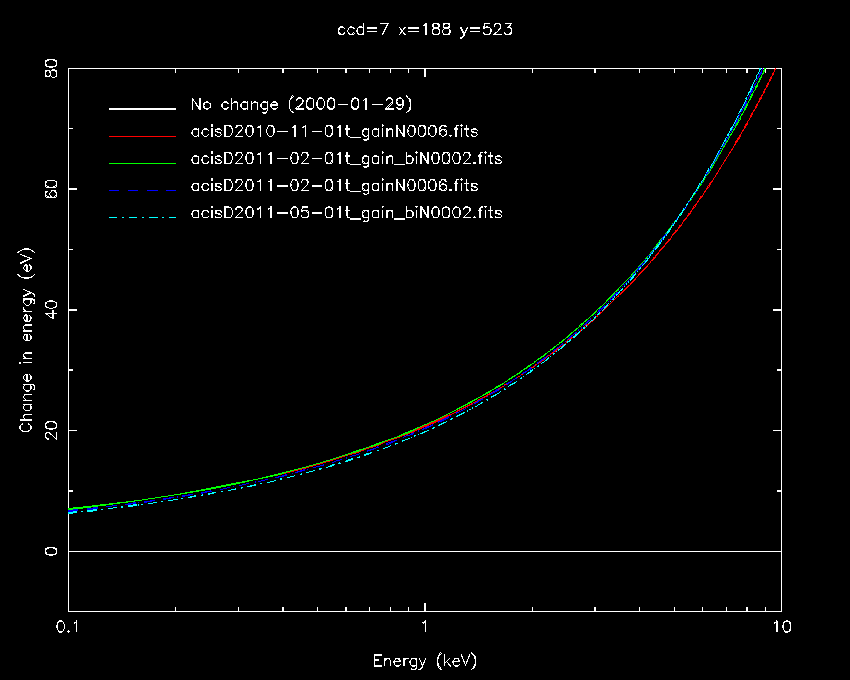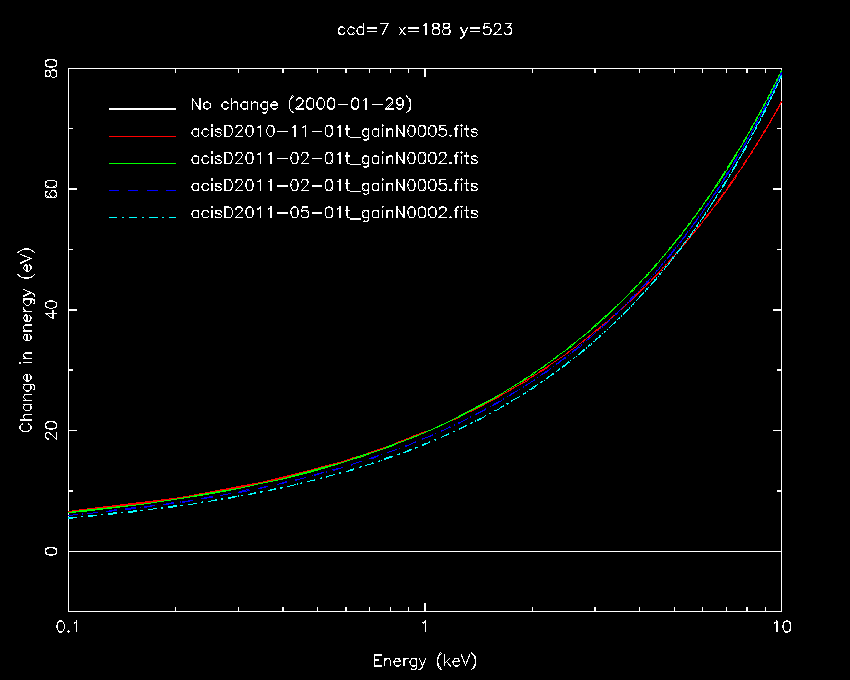CalDB 4.4.6 Public Release Notes
Public Release Date: 13 SEP 2011
SDP Installation Date: 2011-09-15T16:46:27 (UTC)
I. INTRODUCTION
CalDB 4.4.6 is an upgrade to the Chandra CalDB, which includes the following items:
- ACIS T_GAIN Epoch 46
- ACIS -120C DET_GAIN focal plan temperature (FP_TEMP) Range Adjust
- ACIS DOWNSTREAM Calibration FP_TEMP Range Adjust
For the CIAO 4.3 / CalDB 4.4.6 release notes see How CalDB 4.4.6 Affects Your Analysis
II. SUMMARY OF CHANGES
A. ACIS T_GAIN Epoch 46
| Location: | $CALDB/data/chandra/acis/t_gain/ |
| Filename: | acisD2011-02-01t_gainN0006.fits acisD2011-02-01t_gainN0005.fits acisD2011-05-01t_gain_biN0002.fits acisD2011-05-01t_gainN0002.fits |
The periodic ACIS T_GAIN correction upgrade for May-July 2011 has been released. The corrections are at nominal/expected levels of less than 2% of the energy value. This upgrade as usual affects observation data taken over Epoch 46 and 45, and so would update PHAs for OBS_IDs taken since 01 FEB 2011. Users with such datasets are encouraged to revalidate their analysis results after reprocessing their data with the upgraded CalDB files. For specific details of the data in this release, see the technical details section below.
See the ACIS Time-dependent Gain why page for more information.
PIPELINES/TOOLS AFFECTED:
DS and CIAO level 1 (re)processing tool acis_process_events.
Also: CIAO reprocessing script chandra_repro for ACIS data with DATE-OBS after (UTC) 2011-02-01T00:00:00.
THREADS AFFECTED:
Reprocessing Data to Create a New L2 Events File
B. ACIS -120C DET_GAIN focal plan temperature (FP_TEMP) Range Adjust
| Location: | $CALDB/data/chandra/det_gain/ |
| Filename: | acisD2000-01-29gain_ctiN0006.fits acisD2000-01-29gain_ctiN0005.fits acisD2000-01-29gainN0005.fits |
It has come to our attention that the ACIS GAIN (DET_GAIN) files' headers have not been modified for consistency with the latest temperature-dependent CTI correction (T-CTI) calibrations, in that their FP_TEMP boundary condition ranges have not been reset to the new calibration admitance for FP_TEMP of (151.16 - 159.16)K. This new range is the actual range of applicability for the Temperature-dependent CTI files released with CalDB 4.4.1 in December 2010. With this latest CalDB upgrade 4.4.6, this situation has been corrected.
Currently only one OBS_ID is affected (still propietary) because it had an FP_TEMP header value of 158.45K, which exceeds the old FP_TEMP range used in the -120C DET_GAIN file headers. However, more OBS_IDs may be affected by this in the future. The T-CTI correction is still valid for OBS_IDs at this temperature, and up to 159.16K.
PIPELINES/TOOLS AFFECTED:
DS and CIAO level 1 (re)processing tool acis_process_events.
Also: CIAO reprocessing script chandra_repro for ACIS data with DATE-OBS after (UTC) 2010-11-01T00:00:00.
THREADS AFFECTED:
Reprocessing Data to Create a New L2 Events File
C. ACIS DOWNSTREAM Calibration FP_TEMP Range Adjust
|
FILE TYPE (CCNM) |
FILENAME |
CTI_APP (CTI correction configuration) |
AFFECTED CIAO TOOLS / SCRIPTS |
| QEU | acisD2000-01-29qeuN0005.fits | PPPPPNPNPP NNNNNNNNNN |
mkexpmap (mkinstmap), mkarf, mkwarf, mkgarf, fullgarf, fluximage, specextract |
| acisD2000-01-29qeuN0006.fits | PPPPPBPBPP | ||
| P2_RESP | acisD2000-01-29p2_respN0005.fits | PPPPPNPNPP | mkacisrmf, specextract |
| acisD2000-01-29p2_respN0006.fits | PPPPPBPBPP | ||
| OSIP | acisD2000-01-29osip_ctiN0005.fits | PPPPPNPNPP | tg_resolve_events (CIAO and SDP), mkarf, mkwarf, mkgarf, fullgarf, specextract |
| acisD2000-01-29osip_ctiN0006.fits | PPPPPBPBPP | ||
| acisD2000-01-29osipN0006.fits | NNNNNNNNNN | ||
| FEF_PHA | acisD2000-01-29fef_pha_ctiN0004.fits | PPPPPBPBPP PPPPPNPNPP PPPPPNPNNN |
mkrmf, mkwarf, specextract |
| acisD2000-01-29fef_phaN0005.fits | NNNNNNNNNN |
It has recently come to our attention that the -120C ACIS downstream calibration datasets used in CIAO and for grating observations in CIAO and Standard Data Processing, have not been updated with the appropriate FP_TEMP range for the relevant T-CTI corrections released to the public in CalDB 4.4.1. These files include the quantum efficiency uniformity (QEU), order-sorting (OSIP), phase 2 response inputs (P2_RESP, used by CIAO tool mkacisrmf), and FEF_PHA files used in the CIAO tool mkwarf. CalDB 4.4.6 corrects this issue.
Currently only one OBS_ID is affected (still propietary) because it had an FP_TEMP header value of 158.45K, which exceeds the old FP_TEMP range used in the -120C CalDB file headers. However, more OBS_IDs may be affected by this in the future. The T-CTI correction is still valid for OBS_IDs at this temperature, and up to 159.16K.
PIPELINES/TOOLS AFFECTED:
See the table above for tools that use the changed files in the table above. Note however that at present only one OBS_ID (currently proprietary) is affected by this change.
THREADS AFFECTED:
While the changed files in the above table are used in the following threads, only OBS_IDs with FP_TEMPs above 158.2K are affected by this change. Only one such OBS_ID exists at this time, currently proprietary.
Single Chip ACIS Exposure Map and Fluxed Image
Multi-Chip ACIS Exposure Map and Fluxed Image
Extract Spectrum and Response Files for a Pointlike Source
Extract Spectrum and Response Files for an Extended Source
III. TECHNICAL DETAILS
A. ACIS T_GAIN Epoch 46
The ACIS time-dependent gain corrections (T_GAIN) have recently been updated for current changes from the previous T_GAIN epoch, specifically Epoch 46, which was May through July 2011. With the addition of these new corrections, derived from ACIS External Cal Source (ECS) data taken during radiation zone passes, the CalDB files extending from Feb 2011 through April 2011 (i.e. Epoch 45) have been finalized, and new non-interpolating T_GAIN files are now implemented for Epoch 46.
The magnitudes (in eV) of the new gain corrections, versus photon energy, are given in Figs. 1-3 below. The corrections are of the usual order in magnitude, specifically less than 2.0% of the photon energy value. Fig. 1 below gives the corrections for the ACIS-I aimpoint on chip ACIS-3, for the CTI-corrected case, which is the only one applicable to FI chips. Figure 2 gives the corrections for the ACIS-S aimpoint on ACIS-7, for the case where the BI chips are CTI-corrected. Finally Fig. 3 gives the corrections for ACIS-7 for NON-CTI-corrected BI chips. These would be relevant to GRADED DATAMODE observations with ACIS-S, for example.

Fig. 1: ACIS-I3 aimpoint T_GAIN corrections in eV versus
photon energy.

Fig. 2: ACIS-S3 CTI-corrected aimpoint T_GAIN corrections in eV versus
photon energy.

Fig. 3: ACIS-S3 non-CTI-corrected aimpoint T_GAIN corrections in eV versus
photon energy.